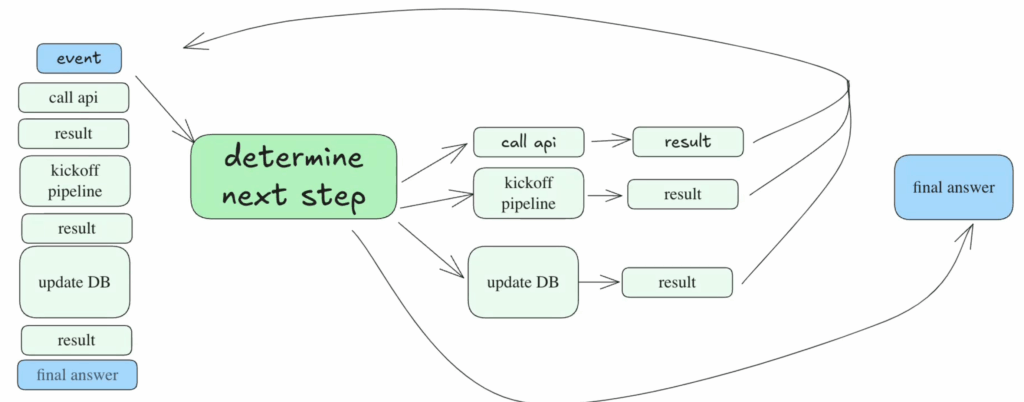The 12-Factor Blueprint for GenAI Agents: A Technical Perspective on Next-Generation Software Design

Solution Architect

Software engineering is undergoing its next fundamental transformation. Just as the original 12-Factor App methodology transformed cloud-native application design nearly two decades ago, we currently face a similar need for a guiding structure and best practices in designing AI-powered agents. Agents represent a new class of semi-autonomous software capable of making decisions, invoking tools, and adapting dynamically based on evolving context. This article explores the “12-Factor GenAI Agents”—a modern adaptation of tried-and-true engineering principles, tailored for the age of generative AI.
What Is an AI Agent?
Unlike deterministic workflows, where every step is predefined, AI agents possess autonomy. They evaluate context, choose actions, and interact with external tools or users without following a hardcoded decision tree. Technically, an agent can be broken down into four primary components:
- Prompt – Instructions that guide the model’s behavior (Prompt Engineering)
- Tools – APIs or functions the model can invoke (OpenAI Function Calling)
- Context – The working memory of the agent, including past actions and results
- Controller – Logic to decide the next step, often based on model output
This shift implies a move from software-as-graph to software-as-loop, where decisions are made dynamically by models based on accumulated context and tool outputs. This looped execution pattern reflects the undeterministic nature of AI agents compared to traditional software.
What’s an agent, really?

12 Factors for AI Agents
- Translate Natural Language to API: Agents must translate human intent (in natural language) into structured API calls. This pattern is foundational, allowing LLMs to interact with external systems like sending emails or querying databases. This mirrors the earliest machine learning systems where models interfaced with deterministic APIs for outputs.
- Respect Your Prompts: Prompts are central to agent behavior. They must be versioned, secured, and treated as source code. Prompt engineering, including prompt injection protection, is critical.
- Hone Your Context Window: Context determines quality. Agents rely on a combination of current prompts and memory (e.g., vector databases) to deliver accurate, non-hallucinated results. The practice of separating long-term and short-term context enables hybrid designs that store data efficiently and scale effectively.
- Design Minimal, Stateless Tools: Tools should be simple, single-action functions (e.g., add(x, y)). Avoid large, monolithic tools. Statelessness ensures consistency and composability. A clear separation of logic into fine-grained callable units improves debugging and upgradeability.
- Unify Execution State with Business State: Execution state (what the agent is doing) and business state (what the system expects) must align. Mismatched states lead to failed automations. Many agent projects fail when agents operate out of sync with business workflows, demonstrating this principle’s importance.
- Pause and Resume with Simple APIs: Agents must support pause/resume operations. This prevents runaway cost and ensures safe, interruptible processes. Without this, agents might consume unnecessary resources or act without supervision.
- Defer to Human-in-the-Loop via Tool Calls: Agents must be able to pass decisions to humans when needed. This can be achieved via APIs that notify, request approval, or await input. This concept ensures accountability, especially in high-risk domains (Human-in-the-Loop).
- Control Flow Management: Long-running tasks, error states, and external dependencies require explicit control flow strategies. Break loops when needed, track states externally. The ability to break or resume looped behaviors ensures reliability and maintainability.
- Prevent Error Propagation through Self-Healing: Agents should be able to identify, report, and recover from errors. Garbage-in-garbage-out applies: ensure that bad context doesn’t cascade into failure. Error loops must be caught early to prevent system degradation.
- Embrace Microagents and Modular Composition: Like microservices, agents should do one thing well. Compose small agents to build large, adaptive workflows. Single-responsibility agents enable testability and reuse. These “microagents” can call one another, forming resilient compositions.
- Keep Flexible I/O Interfaces: Agents should be deployable in varied environments: CLI, HTTP API, GUI, or embedded in apps. Decoupled interfaces future-proof the design. Triggering agents from multiple sources, and capturing outputs across diverse platforms, supports seamless integration.
- Maintain Statelessness in Core Logic: Agent logic must avoid internal state. Use external context storage for memory. Statelessness improves reliability and debuggability. Internal state risks inconsistencies and harder-to-diagnose failures.
GenAI Agents at Work
- Customer Support Automation: AI agents can handle multi-step customer inquiries by integrating with CRM systems, knowledge bases, and email/SMS APIs. These agents autonomously determine the next best action, whether retrieving account info, issuing refunds, or escalating to human agents. Such loops might involve the agent reevaluating steps upon each new input.
- IT Operations and Monitoring: DevSecOps teams can use agents to monitor logs and metrics in real-time. Upon detecting anomalies (e.g., packet loss, CPU spikes), the agent can decide whether to notify an engineer, reboot a service, or trigger diagnostics automatically. This reflects historical patterns where small agents executed scripts, now enhanced with autonomous reasoning.
- Financial Portfolio Management: Agents can analyze market trends, update users about significant movements, and even rebalance portfolios based on dynamic goals or risk parameters—all while interfacing with trading APIs. These agents may use memory and context to assess risk profiles or detect anomalies.
- E-Commerce Personalization: Agents dynamically tailor user experiences, offering product recommendations, adjusting prices, or optimizing checkout flows based on real-time user behavior and inventory status. The adaptability of agents offers near-real-time strategy shifts during browsing.
- Healthcare Triage Systems: In digital health apps, agents can gather patient symptoms, suggest preliminary diagnoses, schedule appointments, or escalate cases to professionals, ensuring both accuracy and safety with human-in-the-loop checkpoints. Prompts and context windows become critical in preserving patient history across sessions.
- Supply Chain Optimization: AI agents can monitor shipment statuses, supplier delays, and inventory levels. Based on current context and historical patterns, they can reroute deliveries or adjust order volumes autonomously. The ability to trigger tool calls or request external verification adds robustness.
Reflections from the Field
Industry veterans have observed that AI agents echo principles found in decades-old systems like Unix tools and network watchdogs. The difference now is autonomy. Instead of hardcoded trees, agents can think. But this doesn’t negate engineering rigor. Instead, it repositions engineers as orchestrators, designing flows where agents, tools, and humans interact seamlessly.
Agent-to-agent communication is an emerging domain. While not yet fully standardized, it will likely become a 13th factor in future updates to this framework. The introduction of protocols like Google’s Agent-to-Agent (A2A) and Model Context Protocol (MCP) suggests an evolving horizon.
Future Outlook
The “12-Factor Agents” approach offers a foundational guide for building resilient, maintainable, and intelligent agent-based systems. It bridges past engineering wisdom with the new frontier of AI autonomy. By adopting these practices, software developers can transition from deterministic pipelines to dynamic, adaptive, agent-driven applications—a necessary leap as we move closer to scalable artificial general intelligence.
Let the agent time begin. Reach out to First Line Software—we are ready to chat about how we can help you bring your AI transformation to life.
